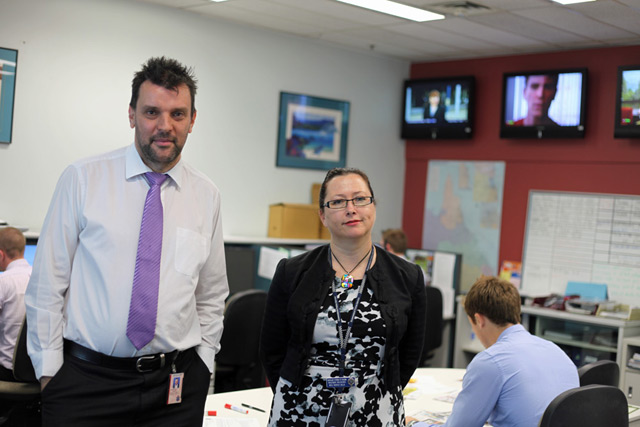ZDNet story: ‘The Digital Beat: policing social media’, July 2012
A feature story for ZDNet; excerpt below. Click the image for the full story.
The Digital Beat: policing social media
Your business may not have to deal with issues of life and death in social media, but there are lessons for everyone in how Australia’s police forces interact with the public.
If you were in Queensland during the floods of January 2011, Kym Charlton’s iPad may have saved your life.
The device itself has since been superseded and effectively retired, yet its weathered, black leather case still features a hastily scrawled note, which, at the time, acted as both a mnemonic and a reality check. Two words in thick, white text: DON’T PANIC.
As executive director of the Queensland Police Service’s (QPS) media and public affairs branch, Charlton [pictured above, centre; to her left, senior digital media officer James Kliemt] was bunkered down in the State Disaster Coordination Centre while then Premier Anna Bligh and her team of emergency-services specialists alternated between internal briefings and live-streamed press conferences.
The matter at hand? How best to deal with an uncanny series of weather events that would ultimately leave 90 per cent of the state declared a disaster zone.
iPad in hand, Charlton was responsible for posting live updates to the QPS social-media accounts — vital information which, for some Queenslanders, meant the difference between fight or flight; home ownership or homelessness; life or death.
Having convinced the deputy commissioner to sign off on a six-month social-media trial in mid-2010, Charlton and her media team had grown the QPS Facebook page to a respectable following of 6500 by the end of the year. As rain saturated the state throughout December, QPS was in the ideal position to establish itself as the state’s singular, trustworthy news source in a time of need.
“It was quite an organic thing for us,” Charlton said from her office in the QPS headquarters just outside of the Brisbane CBD. “We’d been using social media for six months, so we immediately moved to get the information out through those channels, because time was so critical.”
Charlton is a calm and confident narrator, having had plenty of time to reflect on this topic both in private and public — including a presentation at the Global Initiative to Combat Nuclear Terrorism in Marrakech last year — yet it’s clear that the urgency and quality of the work that her team produced in January 2011 is never too far from her mind. The numerous framed awards hanging on her office walls make such matters difficult to forget, in any case.
The QPS social-media presence meant that Charlton didn’t have to waste time with the clearance processes that ordinarily hamper police news dissemination. “Rather than me sitting in a disaster-management meeting, listening to the premier being briefed, taking notes, going out and giving it to someone to write a media release, then spending the rest of the day chasing around incredibly busy people to clear the information, I started to post status updates as I heard the premier being briefed,” she said. A self-imposed limit of 140 characters per update meant that the news could be bounced from Facebook to Twitter with ease, and without diluting the message.
“We were able to pump out a whole lot of information that we knew wouldn’t make the mainstream media; they just wouldn’t have picked up that volume of information. It was quite low level, but it was really important if it was about your area,” she said.
“For example, the day that the Lockyer Valley flooded was the same day that Brisbane and Ipswich realised there was going to be a major flood. All of a sudden, you had the entire population of both cities desperately trying to work out if their houses were going to flood. A lot of people weren’t here in 1974; also, there are way more houses [now] than there used to be. We saw a huge jump of people coming to the page to find that information.” On that particular day, 10 January, Charlton sent her first and last tweets at 4.45am and 11.45pm, respectively.
The numbers surrounding 10 January are astonishing. The QPS Facebook page received 39 million individual story views — the equivalent of 450 page impressions per second — while being updated by staff every 10 minutes or so. (“That amount of traffic would have crashed both our public website and our operational website,” Charlton noted.) Their Facebook audience grew from 16,500 on 9 January to 165,000 within a fortnight; many of those joined the page during the 24-hour period following the Lockyer Valley torrent. Overnight, the QPS social-media accounts had become a lifejacket to which many Queenslanders clung.
Though neither QPS staff nor their newfound legion of followers would have realised it at the time — it’s fair to say that there were far more pressing matters to consider, like whether their houses would go underwater — this confluence of events exemplified the great big promise of social networking that Zuckerberg et al proselytise: to connect humans with one another, and to share meaningful information immediately.
Charlton’s decision to establish and nurture the QPS social-media presence the winter before that unforgettable summer was fortuitous. “We were in that wonderful position where we knew enough to be able to use it [during the floods],” she said. “It wasn’t a decision where anyone said, OK, we’re going to focus on social media’. We just started doing it because it worked.”
For the full 3,700 word story, visit ZDNet. Above photo credit: Andrew McMillen.
